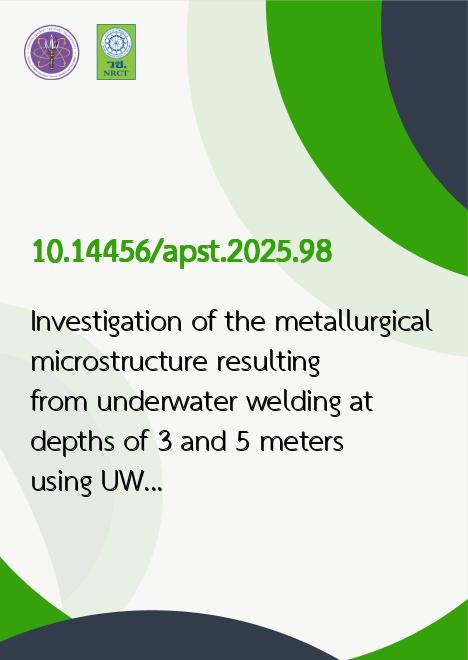
|
Investigation of the metallurgical microstructure resulting from underwater welding at depths of 3 and 5 meters using UW-1 and E6013 welding electrodes. |
|---|---|
| รหัสดีโอไอ | |
| Creator | Thongchai Khrueaphue |
| Title | Investigation of the metallurgical microstructure resulting from underwater welding at depths of 3 and 5 meters using UW-1 and E6013 welding electrodes. |
| Contributor | Arawan Chanpahol, Saksirichai Srisawat, Boonsin Nadondu, Parinyawatr Dhinnabutra |
| Publisher | Khon Kaen University, Thailand |
| Publication Year | 2568 |
| Journal Title | Asia-Pacific Journal of Science and Technology |
| Journal Vol. | 30 |
| Journal No. | 6 |
| Page no. | 15 (13 pages) |
| Keyword | Underwater welding, Hydrogen, Carbon steel, UW-1 electrode, E6013 electrode |
| URL Website | https://apst.kku.ac.th/ |
| Website title | https://apst.kku.ac.th/investigation-of-the-metallurgical-microstructure-resulting-from-underwater-welding-at-depths-of-3-and-5-meters-using-uw-1-and-e6013-welding-electrodes/ |
| ISSN | 2539-6293 |
| Abstract | This study presents a comparative analysis of underwater welding using E6013 and UW-1 electrodes on carbon steel at depths of three and five meters. The investigation focuses on weld quality, microstructure, and hydrogen content. At a depth of three meters, both electrodes produced welds that met standard criteria and were free of porosity, slag inclusion, and cracking. UW-1 produced smoother and more completely fused surfaces, aided by the forehand welding technique and proper electrode angle, which promoted stable metal transfer and clear visibility of the molten pool. scanning electron microscope (SEM) analysis revealed alternating martensite and pearlite in the weld zone (WZ), with E6013 producing more martensite and a coarser structure in the heat-affected zone (HAZ), along with visible separation from the base metal. Energy Dispersive X-ray Spectroscopy technology (EDS) analysis showed hydrogen content in the WZ was 11.02% for E6013 and 6.50% for UW-1, the latter being lower than typical underwater welding levels (7.0–11.7%). In the HAZ, E6013 and UW-1 showed 5.23% and 5.06% hydrogen, respectively. The results suggest that E6013 can serve as a temporary substitute for UW-1 in shallow underwater welding, but its use should be limited to depths not exceeding three meters due to quality control constraints at greater depths. |